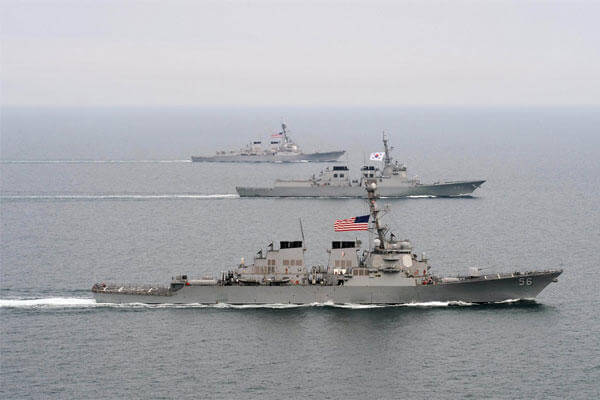The U.S. Navy is in the early phases of a series of engineering and combat systems modernization upgrades to its current fleet of 62 commissioned Arleigh Burke-class destroyers, service officials said.
The planned upgrades are what the Navy calls "Hull, Mechanical & Electrical" or "HME" modernizations. Separate combat systems upgrades are also part of the effort, Navy officials said.
"Every year you have a ship out there is a significant investment in fuel, people and spare parts. What you want is to keep the ship combat relevant so it continues to be able to perform the full range of missions against all the modern threats throughout its life," Capt. Mark Vandroff, program manager for DDG 51 acquisition, told Military.com.
"The ships are getting new bridge control consuls. With the automation and the decision making tools for the bridge-watch standards, you can watch from a bridge that has more information available with potentially fewer people and a higher level of situational awareness," Vandroff said.
The HME upgrades, which have been completed on a handful of ships, also look at the ship's infrastructure to check for stability, corrosion and hull damage.
"A DDG 51 has got to be able to fight and withstand a reasonable amount of battle damage, so you need to keep up with things like corrosion, hull strength and paint," he explained. "If you look at one of the ships that have been through the HME modernization and look at one of its tanks and its bilges -- it looks like a ship that could last another 15 years."
The Navy's fleet of DDG 51s is broken down into several categories determined largely by chronology and technology. The first DDG 51s, the Flight 1s, were built with a vertical launch system for missiles, five-inch guns and a Close-In-Weapons-System, or CWIS, for ship defense. The Flight 1 ships, which include DDG numbers 51 through 71, were built with one landing pad for helicopters, Vandroff explained.
Flight II, which includes ship numbers 72 to 78, adds an organic signals intelligence capability to the ship, he said. Flight IIAs, the most numerous of the Arleigh Burke class-destroyers, are built with two helicopter hangars.
The Flight IIA ships, which include DDG 79 and forward, are also configured with advanced electronics, computing and combat systems compared to prior models.
Four new Flight IIA DDG 51s are now under contract for construction, ships 113 through 116. The ships, slated to begin service by 2016, are named the USS John Finn, USS Ralph Johnson, USS Rafael Peralta and USS Thomas Hudner, Navy officials said.
The midlife modernization upgrades will replace the Flight 1 ship's data multi-plexing system which used an early local area network with gigabit ethernet cables and modern computing technology, Vandroff said.
Also, 1980s-era processors get replaced with modern computers, sensors and cameras to monitor the engine room and other parts of the ship. Manual logs and data collection is replaced by an integrated system with cameras and computers able to monitor trends and other key signals aboard the ship, Vandroff added.
The Navy's USS John Paul Jones, DDG 53, is an Aegis destroyer which has successfully completed both the HME and combat systems upgrades, Vandroff said.
The ship is uniquely configured because it has also been equipped with the latest in integrated ballistic missile defense software, Aegis Weapons System 5.0. This technology, which includes the use of a multi-mission signal processor, allows the ship to conduct air defense and ballistic missile defense mission concurrently, Vandroff explained.
One analyst said the Navy's DDG 51 midlife upgrades could pave the way for integration of newer emerging technologies such as lasers and electromagnetic rail guns.
"The Navy has shown that it can get enormous life extension out of ships so it stands to reason that we ought to be upgrading the DDG 51s possibly several times. The DDG 51 is a capable, multi-mission ship. We should think of these ships holistically and be willing to make changes. We should not think of these things as a closed system but rather think of them in terms of open architecture," said Daniel Goure, vice president of the Lexington Group, a Virginia-based think tank. "Why not think about experimenting as we go forward. Why not put laser weapons on a couple of them?"


























